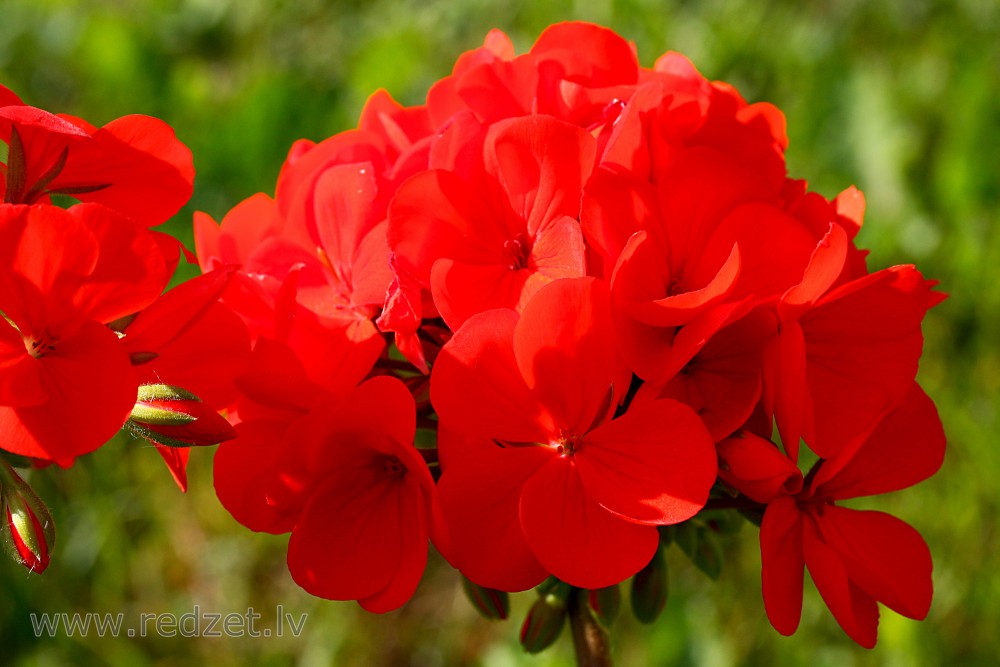Pelargonija (Geraniums)
Pelargonium /ˌpɛlɑːrˈɡoʊniəm/ is a genus of flowering plants which includes about 200 species of perennials, succulents, and shrubs, commonly known as geraniums (in the United States also storksbills). Confusingly, Geranium is the botanical name (and also common name) of a separate genus of related plants often called cranesbills. Both genera belong to the family Geraniaceae. Linnaeus originally included all the species in one genus, Geranium, and they were later separated into two genera by Charles L’Héritier in 1789.
Pelargonium species are evergreen perennials indigenous to temperate and tropical regions of the world, with many species in southern Africa. They are drought and heat tolerant, but can tolerate only minor frosts. Some species are extremely popular garden plants, grown as houseplants and bedding plants in temperate regions. They have a long flowering period, with flowers mostly in purple, red and orange, or white.
Scientific classification
Kingdom: Plantae
Clade: Angiosperms
Clade: Eudicots
Clade: Rosids
Order: Geraniales
Family: Geraniaceae
Genus: Pelargonium
Description
Pelargonium occurs in a large number of growth forms, including herbaceous annuals, shrubs, subshrubs, stem succulents and geophytes. The erect stems bear five-petaled flowers in umbel-like clusters, which are occasionally branched. Because not all flowers appear simultaneously but open from the centre outwards, this is a form of inflorescence is referred to as pseudoumbels.
The flower has a single symmetry plane (zygomorphic), which distinguishes it from the Geranium flower, which has radial symmetry (actinomorphic). Thus the lower three (anterior) petals are differentiated from the upper two (posterior) petals. The posterior sepal is fused with the pedicel to form a hypanthium (nectary tube). The nectary tube varies from only a few millimeters, up to several centimeters, and is an important floral characteristic in morphological classification. Stamens vary from 2 to 7, and their number, position relative to staminodes, and curvature are used to identify individual species. There are five stigmata in the style. For the considerable diversity in flower morphology, see figure 1 of Röschenbleck et al. (2014)
Leaves are usually alternate, and palmately lobed or pinnate, often on long stalks, and sometimes with light or dark patterns. The leaves of Pelargonium peltatum (Ivy-leaved Geranium), have a thick cuticle better adapting them for drought tolerance.
Distribution
Pelargonium is a large genus within the family Geraniaceae, which has a worldwide distribution in temperate to subtropical zones with some 800 mostly herbaceous species. Pelargonium itself is native to southern Africa (including Namibia) and Australia. Southern Africa contains 90% of the genus, with only about 30 species found elsewhere, predominantly the East African rift valley (about 20 species) and southern Australia, including Tasmania. The remaining few species are found in southern Madagascar, Yemen, Iraq, Asia Minor, the north of New Zealand and isolated islands in the south Atlantic Ocean (Saint Helena and Tristan da Cunha) and Socotra in the Indian Ocean. The centre of diversity is in southwestern South Africa where rainfall is confined to the winter, unlike the rest of the country where rainfall is predominantly in the summer months. Most of the Pelargonium plants cultivated in Europe and North America have their origins in South Africa.
Ecology
Pelargonium species are eaten by the caterpillars of some Lepidoptera species, including the moth angle shades. The diurnal butterflies Cacyreus marshalli and C. tespis, native to southern Africa, also feed on Geranium and Pelargonium. C. marshallii has been introduced to Europe and can develop into a pest on cultivated Pelargoniums. It has naturalised along the Mediterrenean, but doesn't survive the winter in Westen Europe.
The Japanese beetle, an important agricultural insect pest, becomes rapidly paralyzed after consuming flower petals of the garden hybrids known as "zonal geraniums" (P. × hortorum). The phenomenon was first described in 1920, and subsequently confirmed. Research conducted by Dr. Christopher Ranger with the USDA Agricultural Research Service and other collaborating scientists have demonstrated the excitatory amino acid called quisqualic acid present within the flower petals is responsible for causing paralysis of the Japanese beetle. Quisqualic acid is thought to mimic L-glutamic acid, which is a neurotransmitter in the insect neuromuscular junction and mammalian central nervous system.
A study by the Laboratory of Apiculture & Social Insects group at the University of Sussex on the attractiveness of common garden plants to pollinators found that a cultivar of Pelargonium × hortorum was unattractive to pollinators in comparison to other selected garden plants such as Lavandula (lavender) and Origanum
en.wikipedia.org






